Zotac ZBOX MAGNUS EN970 Review - A Gaming mini-PC Done Right
by Ganesh T S on September 28, 2015 8:00 AM ESTHTPC Credentials
Despite being actively cooled, I was pleasantly surprised by the noise profile of the system. The fans have variable rotational speeds, and in general, for most media related activities, the fan noise is minimal. I would go as far to say that the noise is probably the lowest amongst all the gaming mini-PCs that we have evaluated.
Refresh Rate Accurancy
Starting with Haswell, Intel, AMD and NVIDIA have been on par with respect to display refresh rate accuracy. The most important refresh rate for videophiles is obviously 23.976 Hz (the 23 Hz setting). The Zotac ZBOX MAGNUS EN970 does not have the same out-of-the-box accuracy possessed by Intel and AMD. However, NVIDIA also allows for setting custom resolutions and refresh rates.
The gallery below presents some of the other refresh rates that we tested out. The first statistic in madVR's OSD indicates the display refresh rate.
Network Streaming Efficiency
Evaluation of OTT playback efficiency was done by playing back our standard YouTube test stream and five minutes from our standard Netflix test title. Using HTML5, the YouTube stream plays back a 720p encoding. Since YouTube now defaults to HTML5 for video playback, we have stopped evaluating Adobe Flash acceleration. Note that only NVIDIA exposes GPU and VPU loads separately. Both Intel and AMD bundle the decoder load along with the GPU load. The following two graphs show the power consumption at the wall for playback of the HTML5 stream in Mozilla Firefox (v 41.0).

GPU load and VPU load were around 16.01% and 21.42% for the YouTube HTML5 stream.GPU load in the steady state for the Netflix streaming case was 5.88% and the VPU load was 4.36%.
Netflix streaming evaluation was done using the Windows 8.1 Netflix app. Manual stream selection is available (Ctrl-Alt-Shift-S) and debug information / statistics can also be viewed (Ctrl-Alt-Shift-D). Statistics collected for the YouTube streaming experiment were also collected here.

Decoding and Rendering Benchmarks
In order to evaluate local file playback, we concentrate on EVR-CP and madVR. We already know that EVR works quite well even with the Intel IGP for our test streams.
In our earlier reviews, we focused on presenting the GPU loading and power consumption at the wall in a table (with problematic streams in bold). Starting with the Broadwell NUC review, we decided to represent the GPU load and power consumption in a graph with dual Y-axes. Nine different test streams of 90 seconds each were played back with a gap of 30 seconds between each of them. The characteristics of each stream are annotated at the bottom of the graph. Note that the GPU usage is graphed in red and needs to be considered against the left axis, while the at-wall power consumption is graphed in green and needs to be considered against the right axis.
Frame drops are evident whenever the GPU load consistently stays above the 85 - 90% mark. An important aspect to note here for NVIDIA GPUs is that the load reported doesn't take into account the GPU clock. For example, the 4Kp30 clip in the EVR-CP mode: Initially, the GPU and VPU operate at higher clocks, resulting in the reported load being 7 - 8% and the power consumption being around 34W. However, later on towards the end of the stream, the load jumps up to around 12%, but the power consumption is now only around 25 W. Essentially, the power consumption at the wall is the real metric of efficiency for decode and playback. As long as the GPU load stays below the 85 - 90% mark, frame drops don't occur.
EVR-CP and madVR Defaults don't present any challenges to the GTX 960
Since the GTX 960 is a powerful GPU, we evaluated madVR with both default and stress settings. The 'madVR stress settings' was configured with the upscaling algorithms set to Jinc 3-tap with anti-ringing activated and the downscaling algorithm set to Lanczos 3-tap, again with anti-ringing activated.
The ZBOX MAGNUS EN970 was able to handle the madVR stress configuration without any issues.
Moving on to codec support, the GTX 970M / GM204 is a known quantity with regards to the scope of supported hardware accelerated codecs.
There is no HEVC_VLD_Main10 support. This is a bit disappointing since the real desktop GTX 960 supports Main10 decoding in hardware. Other than that aspect, the ZBOX MAGNUS EN970 actually makes for a reasonably power-efficient madVR-capable HTPC.


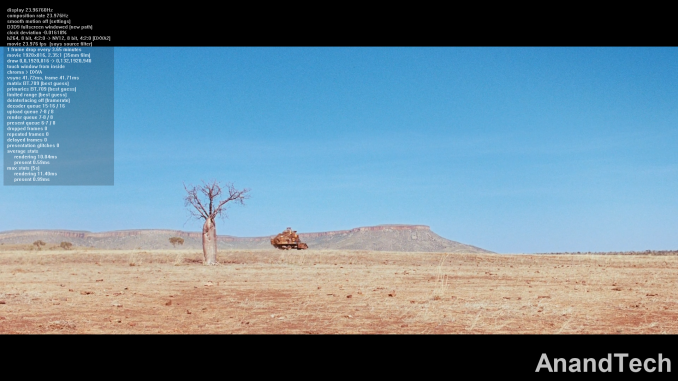



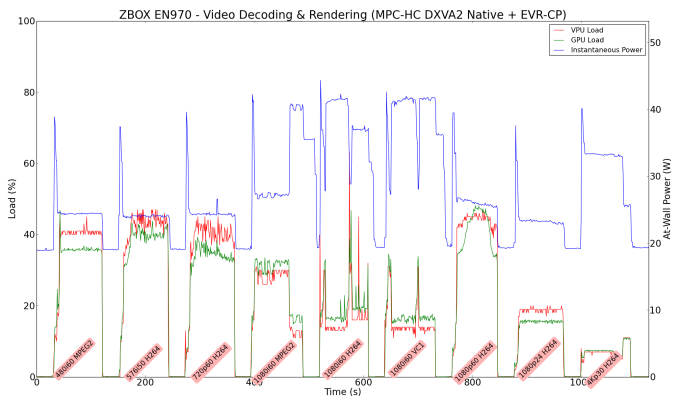
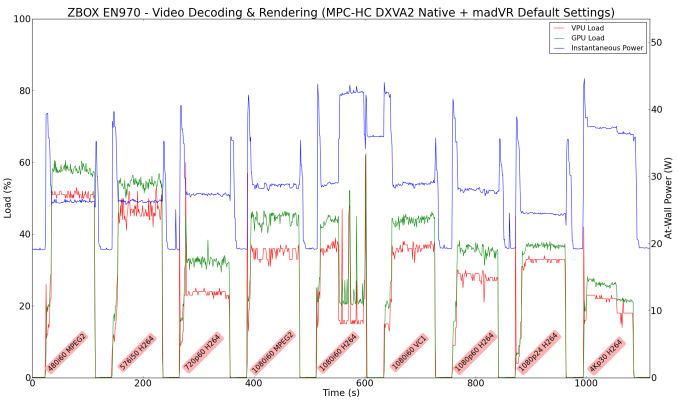
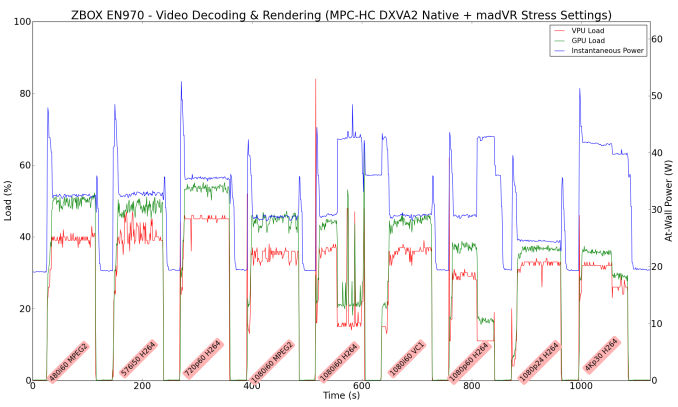
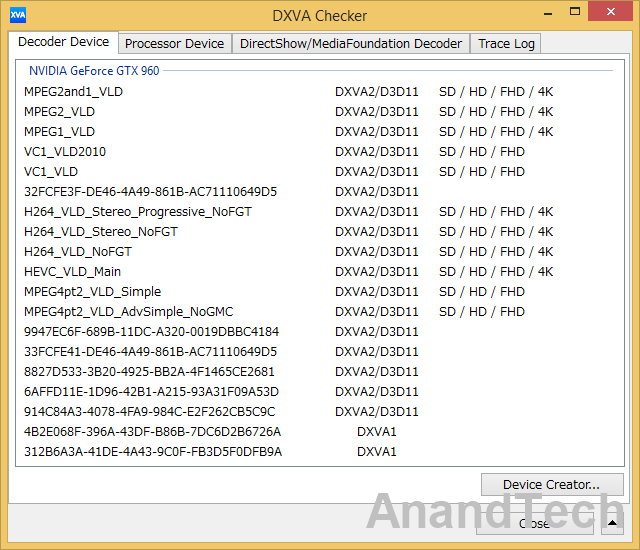








88 Comments
View All Comments
Winterblade - Monday, September 28, 2015 - link
I have to agree with milkod2001, specially if you compare it with the base alienware alpha that cames with storage, OS and even a Xbox controller for half the price of the Magnus barebones.In order to make the Magnus compeling I would like a Quad-core CPU (even if it is a mobile part) and about $150 discount of the barebones price, then I would be all over it.
smorebuds - Monday, September 28, 2015 - link
The Alpha that you're referring to that's half the cost has a 2 year old i3 cpu, 860M gpu, spinning hard drive, and 4 gb of ram. So yes, the Magnus is a more powerful, smaller device, and it costs more money. What's your point?Winterblade - Sunday, October 4, 2015 - link
That 2 year old CPU is a desktop part, should be about the same performance compared to the 5200U, and the GPU is a 860M OCed, so it will handle 1080 gaming just fine, also it has Windows already installed and even an xbox controller, it is ready to use out of the box and it is half the price, that's my point, 400-500 USD is the price these gaming mini PC's have to hit to truly compete with gaming laptops and DIY gaming PC.Jauffins - Saturday, October 17, 2015 - link
The Alienware Alpha can be equipped with any size 2.5" SSD, up to 16GB RAM, and a 2.9 Ghz desktop Core i5 (or i7), all for less than the price of this barebones kit. And my 4590T runs at 65-70c full load, not 100+. The only downfall is the 860m, and I must say I've been very impressed with what it can do, and have yet to run into an issue. As long as you don't expect either of these systems to run The Witcher 3 on Ultra, you're good.meacupla - Tuesday, September 29, 2015 - link
FYI, mITX PC can get quite heavy, easily tipping past 7kg, and they are, at least, 4x as large.My RVZ01 build is 14L and around 8kg.
Compared to a SFF that's 2.23L and probably not even 2kg fully equipped.
schizoide - Monday, September 28, 2015 - link
FINALLY, a very small form factor gaming box with a GPU fast enough to handle all 1080p console ports for the current generation!Unfortunately, the price remains dramatically just way too high. If this came in around $500 like the Alienware Alpha, I would buy it instantly. Of course that would be an 80% discount so obviously Zotac isn't at all interested in fighting on price.
That's what I really want-- an Alienware Alpha with a 970M GPU, as the 860M it comes with just isn't fast enough for solid 1080p gaming. Keep hoping the next-generation Alpha hits that performance level.
smorebuds - Monday, September 28, 2015 - link
Ok but the Magnus has much better parts than the Alpha so why would it be the same price? The Alpha with the "comparable" specs is about the same price as the Magnus. And by "comparable" I mean the Alpha has a shitty spinning hard drive and a 2 year old Haswell cpu and 860M gpu...schizoide - Monday, September 28, 2015 - link
Nope. The CPU doesn't matter for gaming and the Alpha GPU is much slower.smorebuds - Monday, September 28, 2015 - link
What're you saying nope to? So what if zotac made an sku with an i3, 960M, 500gb HDD, and 4gb ram and sold it for $499 would you be happy? That's your alpha in 2015 except in a smaller package which is the whole damn point of this.Jauffins - Saturday, October 17, 2015 - link
I want to see the adoption of MXM. My Alpha is the perfect SFF system (2.9Ghz desktop i5, 16GB RAM, SSD) but in a few years, the 860m will start to show its age. Why nVidia isn't pushing this form factor, where I can spend maybe $200-250 to get an MXM form factor desktop 760 or 960, I don't understand.